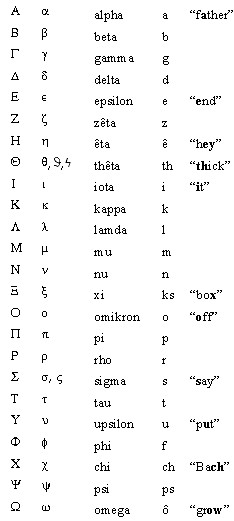
Also see:
Greek dates
Greek Numismatic Dictionary
Letterform Usage - https://www.parthia.com/fonts/letterforms_usage.htm
This table lists the Greek letters, their names, equivalent English letters, and tips for pronouncing those letters which are pronounced differently from the equivalent English letters.1

Sigma (σ, ς): There are two forms for the letter Sigma. When written at the end of a word, it is written like this: ς. If it occurs anywhere else, it is written like this: σ.
 digamma w
digamma w  heta e Ͱ
heta e Ͱ san zs(?)
san zs(?) Ч koppa k
Ч koppa k
 sampi ss ϖ
sampi ss ϖ tsan ts
tsan tsUpsilon (υ): In the above table, we suggest that you pronounce this letter like "u" in "put". The preferred pronunciation is actually more like the German "ü" as in "Brücke", or like the French "u" as in "tu". If you do not speak German or French, don 't worry about it, just pronounce it the way the table suggests.
Chi (χ): This is the same sound as "ch" in "Bach", which does not sound like "ch" in "chair". The same sound occurs in the Scottish "Loch", as in "Loch Lomond", or the German "ach!".
Diphthongs When two vowels combine to make one sound, it is called a diphthong. There are seven diphthongs in Greek:

The "ευ" combination is probably the hardest to learn for most people. It may help to take the "ow" sound and say it slowly: if you notice, there are actually two sounds in "ow" - it starts out with "ah", then glides to an "oo" sound, "ah-oo". Try doing the same with "e" (as in "Edward") and "oo" - "e-oo". This is a little like the "e-w" in Edward, if you remove the "d".
| Keyboard Key | A | B | C | D | E | F | G | H | I | J | K | L | M | N | O | P | Q | R | S | T | U | V | W | X | Y | Z | |
| Symbol Font Upper Case | A | B | C | D | E | F | G | H | I | J | K | L | M | N | O | P | Q | R | S | T | U | V | W | X | Y | Z | |
| Symbol Font Lower Case | a | b | c | d | e | f | g | h | i | j | k | l | m | n | o | p | q | r | s | t | u | v | w | x | y | z |
|
|
The arrows show you where to start when you write Greek letters.1

| A | 1 | I | 10 | R | 100 | ||
| B | 2 | K | 20 | S,C | 200 | ||
| G | 3 | L | 30 | T | 300 | ||
| D | 4 | M | 40 | U | 400 | ||
| E | 5 | N | 50 | F | 500 | ||
| S, ς (stigma) | 6 | X | 60 | C | 600 | ||
| Z | 7 | O | 70 | ||||
| H | 8 | P | 80 | ||||
| Q, ϟ, DE | 9 | 90 |
Date numerals are often preceded by ΕΤΟΥΣ (year in Greek), frequently written or abbreviated ETOYC, ET, or E. L was also a symbol for "year." It probably originated in Egypt and may have been derived from a hieroglyph. Example: LΓΞΡ = Year 163
Greek dates are also sometimes written out or abbreviated. Some examples follow:
ΤΡΙΤΟΥ = year 3The dates as written above may not be "proper" Greek. They are sample dates as actually used on Roman provincial coins minted in Alexandria and other cities.
To date a coin, you need to know the start date for the era. For most Roman coins it is the start of the emperor 's reign. Some other era start dates are listed below:
| Era | Start Date |
| Seleucid | Autumn 312 B.C. |
| Pompeian | 64 B.C. |
| Caesarian | Autumn 49 B.C. |
| Capitolias, Decapolis | 97 A.D. |
| Neopolis, Samaria | 72 or 73 A.D. |
| Dora, Samaria | 64/63 B.C. (variation on Pompeian) |
| Provincial Arabia | 106 A.D. |
| Philadelphia, Syria | 63 B.C. (variation on Pompeian) |
| Chalcis, Chalcidice, Syria | 92 A.D. |
| Anazarbus, Cilicia | 19 B.C. |
If the era started in before the common era, to determine the common era (AD or CE) date, subtract the era start year from the date on the coin. If the result is less than zero, determine the date before the common era (BC or BCE) by subtracting the date on the coin from the era start year and then adding one.
If the era started in the common era (AD or CE), add the start year to the date and then subtract one to determine the common era date.
AUGOUCTA = Augusta
AUTOKRATOR (AUT, AUTOK) = Imperator
GERMANIKOS (GERM) = Germanicus
DAKIKOC (DAK) = Dacius
DHMARCIKHS EXOUCIAC(DHMARC EX) = Tribunicia Potestas
KAISAR (K, KAI, KAIS) = Caesar
PARQIKOC (PAR) = Parthicus
SEBASTOS (SEB) or CEBACTOC (CEB)= Augustus
UPATOC = Consul (usually followed by the number of terms served)
